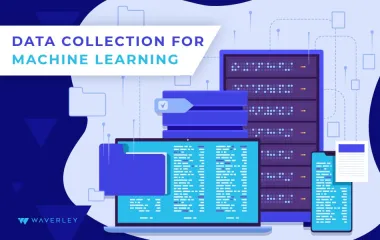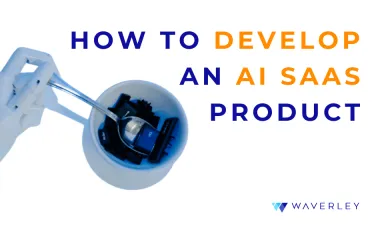AI in IoT App Development: From Concept to Market-Ready Solution
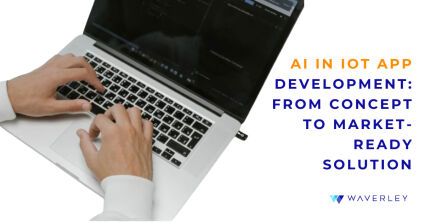
Contents
The combination of Internet of Things (IoT) and Artificial Intelligence (AI) has become a disruptive force that is changing how we view and use devices that surround us. It’s becoming more and more clear that AI and IoT work well together. This is especially true when it comes to app development. The article explores the complex interrelationship between AI and Internet of Things and explains the benefits of this combination for both corporations and developers.
We set out on an adventure to investigate the union of AI and IoT, revealing the possibilities that sit at the forefront of innovation, from improved user experience to previously unheard-of degrees of connectivity. While you’re trying to learn and understand how AI works in IoT app, you can check out our other article, on how to make an IoT app, from the concept to a market-ready solution.
Understanding Artificial Intelligence in IoT App Development
Artificial Intelligence (AI) represents a paradigm shift in IoT app development, taking conventional applications to new levels of intelligence and capability. Here are only a few examples of how AI improved and enriches IoT applications:
Mastery of Data Analysis:
- Scale Handling: AI makes it possible to analyze a lot of datasets produced by Internet of Things devices, processing amounts of data that are greater than what can be handled by conventional systems.
- Pattern Recognition: Deeper insights can be gleaned from the data by using sophisticated machine learning algorithms to identify complex patterns, correlations, and abnormalities.
Capabilities for Making Decisions in Real Time:
- Dynamic Adaptation: AI enables Internet of Things (IoT) devices to make judgments instantly and adjust in real-time to changing conditions.
- Informed reactions: AI algorithms allow devices to react intelligently to changing conditions in place of static pre-programmed reactions, improving the system’s overall responsiveness.
Optimal Use of Resources:
- Beyond Automation: AI actively optimizes resource usage in Internet of Things applications, going beyond simple automation.
- Predictive Allocation: Through the intelligent prediction of resource requirements based on past data, devices will switch to a more economical use of computational power, bandwidth, and energy.
User Preferences and Predictive Analytics:
- Behavioral Analysis: AI studies how users behave over time in order to derive useful information about their preferences and usage trends.
- Personalization: IoT applications can anticipate user wants and preferences for a more customized engagement by using predictive algorithms to personalize user experience.
Modifiable Industrial Procedures:
- Real-time Optimization: AI-enhanced IoT solutions in industrial settings intelligently adjust manufacturing processes to changing conditions.
- Proactive Maintenance: Models for predictive maintenance can detect possible equipment malfunctions, allowing for early measures to avert delays.
Identification of anomalies and enhanced security:
- Anomaly Identification: AI systems are very good at detecting anomalies in data streams, which improves Internet of Things application security.
- Behavioral Analysis: Early identification of possible security threats is facilitated by ongoing device behavior analysis and monitoring.
Cognitive Understanding and Education:
- Continuous Learning: AI enables IoT applications to learn continuously, enabling devices to change and get better over time.
- Cognitive Insights: AI-enabled IoT devices can deliver more useful and contextually relevant information by recognizing patterns and context.
Dynamic Adjustment to the Environment:
- Sensing Changes in the Environment: AI and IoT sensors work together to detect changes in the environment and modify settings accordingly.
- Climate Control: AI can dynamically adjust climate control systems based on historical and real-time data in smart home scenarios.
Now, let’s talk about the ways AI and Internet of Things work together, turning apps into dynamic self-taught entities rather than static tools. With the help of AI, applications respond to preset settings and also learn and change over time to enhance their own performance and flexibility. We are witnessing the birth of a new era in which the combination of AI and Internet of Things redefines the limits of what is possible in app development, as developers employ AI to add a cognitive intelligence layer to IoT apps.
How AI Works with IoT
The Internet of Things (IoT) and Artificial Intelligence (AI) are working together to create new possibilities for application development in this complex world of technology. This section explores the nuances of their partnership, illuminating the processes that arise from the convergence of these two. One key aspect of this synergy is the growing demand for IoT app development services, reflecting the increasing need to create sophisticated and intelligent applications that harness the combined power of these transformative technologies. But now, take a look at the following 7 examples, which will show the possibilities arising from the collaboration between IoT and AI.
Developing and Acquiring Data:
- Internet-connected gadgets: A large number of IoT devices have built-in sensors that collect data continually, producing real-time data streams. These sensors track changes in the surrounding environment, including temperature and motion.
- Utilizing Data for Analysis: Artificial Intelligence leverages this constant flow of data as a basis for analysis. It turns the data gathered by Internet of Things sensors into actionable insights which can be used in many different ways.
AI-Powered Insightful Analysis:
- Complex Data Processing: AI models perform in-depth analysis to identify trends, patterns, and anomalies in the flow of data provided by IoT devices.
- Meaningful Interpretation: AI provides a deeper comprehension of the operational context and user behavior by extracting insights from the data by analyzing its subtleties.
Methods such as Data Learning:
- Continuous Learning Algorithms: Learning algorithms allow systems to gradually improve their understanding by constantly evolving and adapting in response to new facts.
- Adaptive Systems: This flexibility is essential, particularly in situations where user behavior or the environment are constantly changing.
AIoT Systems that are Edge- and Cloud-based:
- Cloud for Extensive Processing: AIoT systems that are cloud-based are well-suited to jobs involving extensive data processing. Large datasets are frequently analyzed centrally by these systems, which provide insightful analysis and forecasts.
- Edge for Real-Time Reaction: In contrast, edge-based AIoT systems move AI capabilities closer to the source of the data. This lowers latency and improves responsiveness by enabling real-time decision-making.
Making Decisions in Real Time:
- Instantaneous Responses: Real-time decision-making is made possible by AI integrated into Internet of Things applications. This is especially helpful in situations like driverless cars, industrial automation, and smart home systems when quick decisions are essential.
- Dynamic Adaptation: By enabling systems to adjust dynamically to changing conditions, real-time decision-making maximizes operational effectiveness.
Loops of Feedback for Ongoing Improvement:
- Iterative Improvement: AI-powered Internet of Things apps use feedback loops to continuously improve their models. Iterative improvements are facilitated by feedback from external factors, system performance, and user interactions.
- Improved Accuracy: This iterative procedure guarantees improved alignment with user expectations, improves prediction accuracy, and refines system performance as a whole.
Measures for Privacy and Security:
- Anomaly Detection for Security: By using anomaly detection techniques, AI significantly contributes to the security of IoT networks. Unusual patterns or behaviors that can point to security risks are automatically detected and personnel is notified in real-time.
- Preservation of Privacy: AI technologies also play a key role in the implementation of privacy policies, guaranteeing that private user information is managed with the highest secrecy and adherence to privacy laws.
Opportunities of IoT and AI Combined
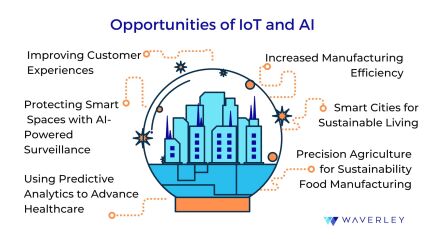
The combination of IoT and AI offers a wide range of options, with the potential to produce breakthroughs that cut beyond industrial borders. We are at the cusp of a technology revolution that might fundamentally and positively alter our world, provided companies and inventors keep exploring and capitalizing on this combination. The combination of these areas opens up a world of possibilities that will change the way we work, live, and engage with the outside world. AI and IoT together have been proven to affect the following aspects:
- Improving Customer Experiences: The convergence of IoT and AI is transforming the retail and customer service sectors. IoT devices are used by smart retail systems to collect consumer data, which is then analyzed by AI algorithms to customize the shopping experience. This confluence improves consumer engagement, pleasure, and loyalty in a variety of ways, from virtual assistants providing personalized recommendations to predictive inventory management.
- Protecting Smart Spaces with AI-Powered Surveillance: The convergence of AI and IoT is transforming surveillance systems in the field of security. Artificial intelligence (AI) algorithms included in smart cameras allow them to differentiate between suspicious and typical activity, which improves danger detection. This improves public safety and has uses in protecting sensitive infrastructure, commercial buildings, and private areas.
- Using Predictive Analytics to Advance Healthcare: The combination of IoT and AI has enormous potential benefits for the healthcare sector. Medical gadgets that are connected can keep an eye on patients’ health all the time, gathering data in real-time that artificial intelligence algorithms can use to identify possible problems early. AI-powered predictive analytics is enabling preventive healthcare interventions and individualized treatment regimens, enabling a desired shift towards precision medicine.
- Increased Manufacturing Efficiency: The fusion of AI and IoT signals the start of a new era of intelligent production processes in the manufacturing sector. By using AI algorithms to analyze data from connected devices, smart factories are able to detect equipment failures, optimize production schedules, and reduce downtime. As a result, the industrial environment is more productive and economical and can quickly adjust to shifting market demands.
- Smart Cities for Sustainable Living: The idea of “smart cities” originated from the incorporation of AI and Internet of Things into urban planning. Urban living is enhanced by this synergy in a number of ways, including energy-efficient infrastructure, intelligent traffic control systems, and trash disposal optimization. AI-driven analytics has the potential to improve city services, lessen environmental impact, and raise the inhabitants’ quality of life overall by utilizing data from diverse sources.
- Precision Agriculture for Sustainability Food Manufacturing: IoT sensors gather data on crop status, weather, and soil health in agriculture; artificial intelligence then evaluates this data to deliver useful insights. Farmers can maximize the use of resources, cut down on waste, and increase agricultural yields because of this synergy. With the use of IoT and AI, precision agriculture is leading the way in sustainable agricultural methods and providing food security for the world’s expanding population.
Check out our article on How to Integrate AI into Your Business for actionable insights and strategies.
Data Integration: The Backbone of AI and IoT
Now, it is clear that AI and IoT have a great synergy and all of that needs a perfect exchange of data. Thus, this part examines the many approaches to data integration to enable successful cooperation between the two technologies:
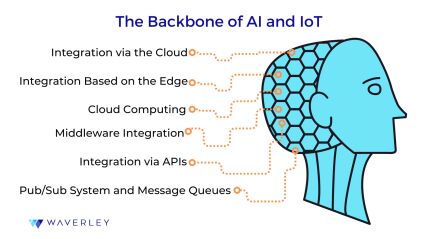
Integration via Cloud:
- Central Processor: Data from Internet of Things (IoT) devices is transferred to centralized cloud servers for processing as part of cloud-based integration.
- Scalability: This approach has the capacity to handle substantial data sets and intricate artificial intelligence algorithms, which makes it appropriate for applications needing a lot of processing power.
- Online Availability: AI models may be accessed remotely thanks to cloud-based integration, making it easier to update and modify them without physically touching the device.
Integration Based on the Edge:
- Autonomous Preparation: To improve real-time decision-making and reduce latency, edge-based integration processes data closer to the source, at the network’s edge.
- Traffic Effort: Local data analysis ensures that only pertinent information is sent to centralized systems, maximizing bandwidth use.
- Lag-Sensitive Scenarios: In fields like industrial automation and driverless cars, edge computing is essential for applications where latency is a major factor.
Cloud + Edge Mix:
- Middle Processing Units: By placing intermediate processing units in between edge devices and centralized cloud servers, cloud computing expands on the idea of edge computing.
- Dispersed Knowledge: By distributing the workload across edge devices and cloud servers, this technique allows for distributed intelligence, which improves efficiency and lowers latency.
- Increased Reliability: Fog computing is especially helpful in situations that call for a mix between local and centralized processing and real-time processing.
Middleware Integration
- Networking Agents: Middleware serves as an intermediary, enabling communication between AI systems and Internet of Things devices.
- Standard APIs are a common feature of middleware solutions, which facilitate integration and encourage device interoperability.
- Real-time Contact: By facilitating direct interaction between hardware and AI components, middleware integration improves system responsiveness.
Integration via APIs:
- Compatibility via APIs: API-based integration uses Application Programming Interfaces (APIs) to facilitate communication between AI systems and Internet of Things (IoT) devices.
- Uniformity: APIs facilitate easy integration and interoperability by giving disparate components a uniform means of interacting.
- Flexibility: By using this technique, developers may create modular systems that can have new features added or removed without causing a lot of problems.
Pub/Sub Systems and Message Queues:
- Asynchronous Communication: AI components and IoT devices can communicate asynchronously thanks to message queues and publish/subscribe (Pub/Sub) systems.
- Load Balance: By controlling message flow, avoiding bottlenecks, and maximizing data processing, these systems guarantee effective load balancing.
- Event-Driven Architecture: Devices that generate events that trigger AI processes are a good fit for message queues and pub/sub systems.
AIoT App Development Platforms and Tools
A wide range of tools have surfaced in the ever-evolving field of AIoT (Artificial Intelligence of Things) app development to enable developers to fully realize the synergy potential between the Internet of Things and Artificial Intelligence. These specialized tools simplify the development process and offer a strong basis for building intelligent, connected apps that have the potential to transform entire sectors. Let’s examine a few of the major tools that are fostering innovation in the creation of AIoT apps in the following table:
| Technologies | ||
|---|---|---|
| Machine Learning Frameworks | Computer Vision Technologies | Natural Language Processing (NPL) Tools |
|
|
|
| Firmware Development Tools | Edge Computing Platforms | Data Analytics and Visualization Tools |
|
|
|
| Security and Privacy Tools | Edge AI Accelerators | IoT Development Platforms |
|
|
|
Key Components of AIoT Applications
Applications for the Internet of Things (IoT) or Artificial Intelligence of Things (AIoT) are complex ecosystems that combine AI (Artificial Intelligence) with an enormous network of interconnected objects. These applications consist of a number of essential elements, each of which is vital to maximizing the combined potential of AI and IoT. The following is a summary of the fundamental elements that make up AIoT applications:
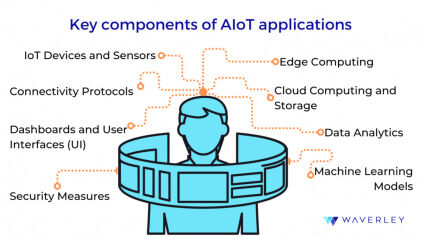
- IoT Devices and Sensors: By gathering data from their surroundings, sensors act as the AIoT applications’ sensory organs. A vast range of gadgets, including cameras, accelerometers, temperature sensors, and others, can be included in this category. The main input source for AIoT applications is sensors, offering the unprocessed data required for analysis and judgment. Applications can obtain a complete picture of the physical world thanks to the variety of sensors available.
- Connectivity Protocols: They make it easier for Internet of Things devices and central processing units to communicate. Typical protocols are HTTP/HTTPS, MQTT, and CoAP. These protocols facilitate the smooth transfer of data from sensors to edge computing or cloud computing platforms, guaranteeing a dependable and effective information flow.
- Dashboards and User Interfaces (UI): The interface serves as the primary point of contact between end users and AIoT applications. Dashboards let users manage and keep an eye on linked devices while displaying visualizations of data insights. AIoT applications are made accessible and user-friendly by their user interfaces. They improve user experience by giving users the ability to see data trends, operate gadgets, and get useful information.
- Security Measures: To protect data and guarantee the integrity and privacy of AIoT applications, developers use protocols for authentication, authorization, and encryption. Strong security measures are essential to guard against cyber attacks, illegal access, and data breaches as a result of the growing interconnection of devices.
- Edge Computing: This technology reduces latency and eliminates the need to send massive amounts of data to the cloud by processing data locally on Internet of Things (IoT) devices or at the network edge. Because edge computing enables prompt analysis and decision-making at the data source, it alleviates the load on central servers and improves the real-time capabilities of AIoT applications.
- Cloud Computing and Storage: Cloud platforms offer AIoT applications centralized, scalable processing power and storage. The enormous volumes of data produced by IoT devices are managed and stored via cloud storage systems.AIoT applications are guaranteed to be scalable and accessible thanks to cloud services, which facilitate long-term storage, machine learning model training, and thorough data analysis.
- Data Analytics: Sensor data collection, processing, and interpretation are all part of data analytics. This comprises prescriptive analytics for action recommendations, diagnostic analytics for problem identification, predictive analytics for forecasting, and descriptive analytics for understanding historical trends. Raw data is transformed into insightful knowledge with the help of machine learning models and through data analytics, which lays the groundwork for well-informed decision-making.
- Machine Learning Models: ML models define predictions or choices without the need for explicit programming by analyzing patterns in data. Techniques for supervised or unsupervised learning can be used to train these models. AIoT apps become more intelligent with the addition of machine learning, which enables them to learn from, adapt to, and optimize depending on data trends. With the help of this component, applications are able to make predictions and judgments.
How to Develop an AIoT App: 10 Steps
As technology continues to advance at a quick pace, developing an AIoT application calls for a methodical and knowledgeable approach. Let’s look at a number of carefully thought-out milestones, each of which is essential to determine the course of development.
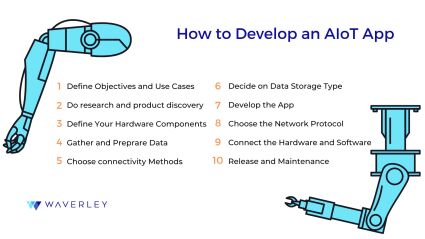
Step 1. Define Objectives and Use Cases
Prioritizing the goals and use cases of the application during the first stages of AIoT app development will help you create a clear vision. Anybody looking to develop a software product should start with defining the objectives and purposes of the AIoT application, as well as the opportunities and difficulties unique to the selected domain. Developers can set a strong foundation for future development phases by clearly defining the use cases and ensuring that the application is in line with the real-world needs of its users.
Step 2. Do Research and Discovery
The period of study and discovery involves an in-depth exploration of the current state of solutions, developing technology, and possible obstacles. This step entails a careful analysis of pertinent case studies, cutting-edge trends, and industry standards. Through thorough research, developers can obtain important insights that guide strategic choices, guaranteeing that the AIoT application is not just technologically sound but also positioned to meet or even exceed user expectations.
Step 3. Define Your Hardware Components
Developers select and specify the crucial elements that will make up the AIoT application’s physical architecture in this hardware-centric step. This entails picking sensors, actuators, and other components in accordance with the particular specifications of the established use cases. The goal is to establish a network of hardware components that are well-integrated and capable of efficiently capturing and transmitting data, thereby laying the foundation for the overall operation of the program.
Step 4. Gather and Prepare Data
Planning for data gathering is a cornerstone of any AIoT application. IoT developers specify the kinds of data that their devices will produce, taking into account both the volume and quality of data. It is critical to set strict guidelines for preprocessing and cleaning the acquired data in order to guarantee that the information supplied to AI models is correct, dependable, and suitable for generating insightful conclusions.
Step 5. Choose Connectivity Methods
Selecting the best connectivity strategies is essential to facilitating smooth communication between IoT devices and the CPU. With consideration for variables like latency, bandwidth, and security, developers must choose communication protocols wisely. Creating dependable and effective connections that enable seamless data transfer across the AIoT ecosystem.
Step 6. Decide on Data Storage Type
Choosing an appropriate data storage system is a strategic choice based on the AIoT application’s needs for scalability, accessibility, and speed of retrieval. Developers assess the type of data generated and the overall data management strategy of the application when weighing the advantages of cloud storage, edge storage, or a hybrid approach.
Step 7. Develop the App
AIoT application’s software components include creating the logic and user experience for the application as well as ensuring smooth integration with AI and machine learning models. Constructing a reliable and responsive application requires careful consideration of the programming languages and frameworks that are most suited to the particular requirements of IoT and AI development.
Step 8. Choose the Network Protocol
To control the communication between Internet of Things devices and the central processing unit, network protocols must be carefully considered. The choice of protocol must be made by developers with consideration for the unique needs of the application, since it will have an immediate effect on the effectiveness of data transfer and overall performance.
Step 9. Connect the Hardware and Software
Connecting the hardware components of choice with the software components created at the previous stage is the task of this integration phase. It is crucial to make sure that sensors, actuators, and the application all communicate with each other seamlessly. Extensive testing is carried out to detect and resolve any potential integration problems, ensuring the system’s general performance and dependability.
Step 10. Release and Maintenance
The AIoT application is made available to users or clients in the last stage. After the product is released, developers establish a thorough maintenance schedule that takes care of possible problems, updates software as necessary, and adjusts to changing user needs. In the dynamic world of AIoT, the application’s long-term performance depends on ongoing monitoring and improvement.
Real-World AI and IoT Examples
Personalized healthcare, intelligent city traffic optimization, and predictive maintenance in manufacturing are just a few of the industries that are being revolutionized by AI and IoT working together. See the following table for other examples:
| Field | Example |
|---|---|
| Agriculture | Precision Agriculture: Precision farming is revolutionizing agriculture with AIoT applications. Drones and other Internet of Things (IoT) devices gather information on crop health, weather patterns, and soil characteristics. Farmers can optimize pest management, fertilization, and irrigation with actionable insights provided by AI systems. Precision farming increases agricultural yields, conserves resources, and encourages environmentally friendly farming methods. |
| Supply Chain and Logistics | Predictive Logistics: IoT devices are used by AIoT applications in logistics to track shipments and keep an eye on transit conditions. Artificial intelligence systems forecast delivery times, possible delays, and the best routes by analyzing previous data and current information. This lowers operating costs, increases delivery reliability, and improves supply chain visibility. |
| Smart Manufacturing | Predictive Maintenance in Industrial Equipment: AIoT is transforming maintenance procedures in the manufacturing industry. AI algorithms are used by predictive maintenance systems to evaluate data from IoT sensors integrated into industrial equipment. These technologies enable proactive maintenance by anticipating probable problems before they happen through real-time equipment condition monitoring. As a result, there is less downtime, less money spent on maintenance, and more overall operational efficiency. |
| Healthcare | Remote Patient Monitoring: AIoT applications are critical to the healthcare industry, especially for remote patient monitoring. Data about patient health is continuously collected by wearable devices with IoT sensors installed. This data is analyzed by AI systems to find anomalies or early warning indicators of health problems. Remote patient monitoring improves patient well-being, enables prompt treatments, and gives medical staff insightful information about their patients’ health. |
| Smart Cities | Intelligent Traffic Management: AIoT is used in smart cities to improve traffic control. Real-time traffic pattern data is gathered by connected cameras and sensors, and AI algorithms evaluate this data to dynamically modify traffic light timings. This lessens traffic jams and enhances the overall traffic flow, which enhances the efficiency of transportation systems and lessens their negative environmental effects. |
| Retail | Personalized Shopping Experiences: AIoT is used in retail to provide individualized shopping experiences. IoT devices in retail establishments gather information about the tastes and actions of their patrons. This data is analyzed by AI systems, which provide real-time targeted recommendations and promotions. As a result, retailers are able to comprehend and accommodate individual preferences, which raises customer happiness. |
Challenges and Considerations
There are many opportunities in the field of AIoT app development, but there are drawbacks as well. Combining AI and IoT opens up a world of possibilities for connectivity, efficiency, and creativity in many different industries. To successfully navigate this environment, one must have a thorough awareness of the challenges and factors involved in combining intelligent algorithms with networked devices. Keep the following things in mind:
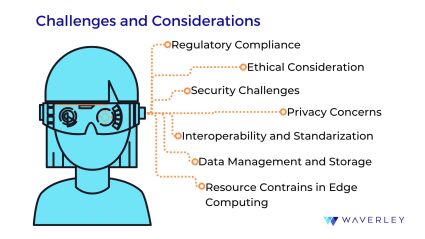
- Regulatory Compliance: Companies working in those two fields need a deep grasp of cybersecurity, data protection, and industry-specific laws given the constantly changing regulatory environment. The deployment of AIoT applications in a way that is both ethically and legally compliant requires ensuring compliance with developing standards.
- Ethical Considerations: When AI is integrated with IoT, ethical issues arise that range from resolving biases in AI models to guaranteeing impartial and transparent decision-making. While creating applications, developers need to consider these ethical factors to give justice, accountability, and transparency top priority.
- Security Challenges: One major security risk posed by IoT devices is their networking nature. Cyberattacks have the potential to affect the physical systems that AIoT apps operate, as well as compromise critical data. To reduce the possibility of future cyberattacks, companies must put in place strong security measures such as encryption and secure authentication.
- Privacy Concerns: Privacy concerns are raised by the significant data collection that AIoT applications inherently involve. To guarantee the responsible use of information, user data must be safeguarded via security measures such as anonymization, user consent, and compliance with privacy laws.
- Interoperability and Standardization: Due to the wide range of IoT platforms and devices, interoperability must be carefully taken into account. In order to create a unified and scalable AIoT ecosystem, developers must strive for standardized protocols that guarantee smooth communication between devices made by various manufacturers.
- Data Management and Storage: To manage the significant amount of data produced by IoT devices, effective data processing and storage systems are essential. To maintain maximum application performance, developers must create architectures that strike a compromise between regulatory compliance, scalability, and accessibility.
- Resource Constraints in Edge Computing: Edge devices are subject to resource constraints when using edge computing for AIoT applications. To strike a compromise between the demands of computing power and the constraints of edge devices, developers must optimize AI models for efficiency.
AI and IoT Synergy for Future Innovation
The Artificial Intelligence of Things domain, along with the latest Internet of Things trends, has an obvious potential for solving current problems and opening up previously unrealized opportunities. This might help to shape a future in which intelligent connectivity is associated with efficiency and progress. Here are a few instances:
- The Emergence of Explainable AI: This point highlights the vital need for AI models to be transparent and explainable as AIoT applications become more integrated into important decision-making processes. This is addressed by the rise of Explainable AI, which makes sure that decision-making processes in AI systems are comprehensible and interpretable, increasing user and stakeholder trust.
- The Development of AIoT Ecosystems: The development of interconnected ecosystems holds the key to the future of AIoT. Internet of Things and Artificial Intelligence technologies working together are creating comprehensive solutions where gadgets talk to each other and rapidly adjust to the environment. Establishing interoperable protocols and standardized frameworks is essential to creating unified AIoT ecosystems.
- Developments in Edge AI: One development worth mentioning is the rise of Edge AI, which refers to the direct use of AI capabilities on IoT devices or at the network edge. This development lessens the reliance on centralized cloud resources, improves real-time processing, and minimizes latency. Edge AI is essential for applications requiring quick reactions, including smart city infrastructures and driverless cars, since it helps devices to make speedy, context-aware judgments.
- AIoT in Healthcare for Personalized Medicine: AIoT is opening doors for personalized medicine in the healthcare industry. AI algorithms and connected medical equipment evaluate patient data to customize treatment regimens. This movement promises more efficient and patient-centered solutions, signaling a departure from conventional one-size-fits-all approaches to healthcare.
- 5G Integration for Better Connectivity: By offering unmatched connectivity speed and low latency, 5G networks are spurring AIoT innovation. This connection opens up new opportunities, especially in fields like augmented reality apps, smart grids, and advanced industrial automation that need large-scale data exchanges.
- AIoT for Enhanced Urban Resilience in Smart Cities: As smart cities develop, they make use of AIoT to improve urban resilience. For example, utilizing real-time data helps create trash management systems that optimize collection routes, or systems for intelligent traffic management. As a result of the AIoT’s incorporation into urban infrastructure, cities will become more sustainable, effective, and receptive to the needs of their residents.
- Exponential Growth in Industrial AIoT: As a result of the industrial AIoT’s adoption, manufacturing processes are undergoing a radical change. Some of the domains that profit from the integration of AI and IoT are supply chain optimization, quality control, and predictive maintenance. The outcome – Increased overall productivity, decreased downtime, and enhanced operational efficiency.
- AIoT in Agriculture for Precision Farming: The combination of AI and IoT in agriculture is promoting precision farming. AIoT applications monitor crop health, adjust irrigation, and forecast harvest periods by analyzing data from sensors and drones. By maximizing the use of resources, this trend not only increases crop yields but also supports sustainable farming methods.
AIoT: Conclusion
Our examination of AIoT highlights how combining AI with the Internet of Things can have a revolutionary effect on modern technology. The process of developing an AIoT application is not an easy one, but when successfully accomplished, can significantly enhance the outcome for businesses relying on this tech combination. The real-world applications in a variety of industries demonstrate how AIoT is more than just a convergence of technologies; rather, it is a driving force behind genuine advances in fields like personalized healthcare, predictive maintenance, and improved urban living.
The difficulties and factors involved in the creation of AIoT, from security and privacy to regulatory compliance, highlight the necessity of a thorough and careful approach. Innovation and responsible application development must be carefully balanced as technology and ethical issues change together. The importance of IoT and AI in influencing application development going forward is becoming increasingly clear as time goes on. The combination of these technologies not only increases productivity but also creates new avenues for creativity by providing answers to challenging problems in a range of sectors.
Embracing the potential of AIoT means more to developers, businesses, and enthusiasts than just creating applications; it means making a positive impact on a future where connectivity and intelligence combine to improve society.
Discover excellence through the power of AI in IoT
FAQ
What is the difference between AI and IoT in app development?
Artificial Intelligence (AI) in App Development: AI is concerned with giving apps intelligence so they can think, learn, and act. It improves the app’s predictive analytics, image recognition, and natural language processing features, for example: ChatGPT.
IoT in App Development: IoT is the process of attaching physical objects to the internet so that they can exchange and gather data. IoT makes it possible to integrate data from these linked devices into app development, providing real-time control and insights.
What industries are benefiting the most from AIoT applications?
- Manufacturing: Predictive maintenance using AIoT optimizes processes.
- Healthcare: Personalized medicine and remote patient monitoring.
- Smart Cities: energy efficiency, trash management, and traffic control.
- Agriculture: Utilizing real-time data, precision farming is practiced in agriculture.
- Retail: Customized shopping experiences.
- Logistics: e.g. AI-powered predictive logistics.
How is AI used in IoT?
- Data Analysis: To derive actionable insights, AI analyzes enormous volumes of data from Internet of Things devices.
- Decision-Making: AI algorithms use processed IoT data to assist with well-informed decisions.
- Predictive Capabilities: By utilizing historical IoT data, AI forecasts future trends, situations, or maintenance requirements.
- Automation: AI uses data from IoT sensors in real-time to automate responses or activities.
What does IoT AI mean?
Artificial Intelligence of Things, or AIoT, is the term used to describe the combination of AI technology with Internet of Things devices and systems. Through the ability to analyze data, make wise judgments, and dynamically adapt to changing conditions, this synergy seeks to improve the capabilities of Internet of Things applications. An ecosystem that is more responsive, intelligent, and efficient is produced by combining AI with IoT across a range of businesses.
Discover the possibilities of AI in IoT.


